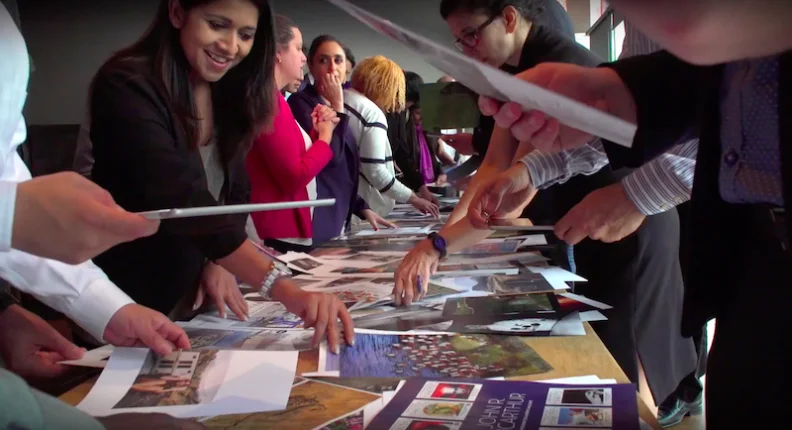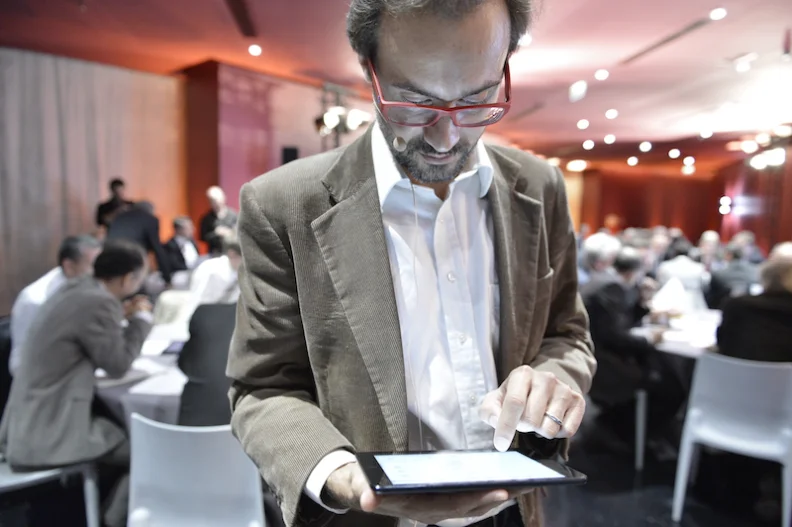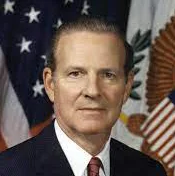We have been practicing collaborative workshops since 2012 the very beginning of Stormz so after thousands of workshops, it is obviously deeply rooted in our mindset and work-culture. This might explain why we are always surprised when we notice that a large majority of business people still remain unaware of the potential impact of collaborative workshops for team performance and collaboration.
This article was originally written by Alexandre in 2014 and this is still the case in 2023, so let's do a brief explanation of what is a collaborative workshop and why everybody should practice the art of facilitation.
Definition - what is a collaborative workshop?
A collaborative workshop is a specific kind of meeting in which a group of active participants applies methodologies to analyse problems, brainstorm ideas, craft solutions, take decisions and/or create plans.
You might also hear the words facilitated meetings, gamestorming, innovation games, visual meetings which designate specific forms of collaborative workshops using a different set of methods or tools.
Do your first collaborative workshop with Stormz!
Stormz is an easy-to-use facilitation platform for productive collaborative sessions: onboard participants in 30 seconds, nobody is left behind, everybody is enjoying the ride!
What for? What can I achieve?
When mentioning collaborative workshops, people often think of brainstorming. But you can run collaborative workshop to achieve all kinds of business objectives, such as:
- Brainstorming: generate brand name ideas, craft creative product concepts
- Problem Solving: analyse root causes of a problem, assess risks
- Marketing analysis: assess a market, find the right positioning on a market
- Strategic: analyse your organisation's stengths & weaknesses, build a common vision
- Project management: identify projects, plan a project, conduct agile retrospective
- Decision Making: prioritise actions, analyse alternatives
- Team building: break the ice, solve internal team problems
And these are just a few examples...

Who is involved?
People are the most precious asset of a workshop. They can have various roles but the main difference with traditional meetings is that they all actively participate to the process and to building the output. Here are some of the most common roles during a workshop:
- The facilitator: Prepares, designs and usually leads the workshop
- The participants: active participants that contribute their insights and ideas and work together to co-develop the final deliverable of the session
- The sponsor: The sponsor is the person asking for the workshop to happen so it is important to identify their expectations to be sure the session will meet their goals
Focus on the facilitator
The facilitator may or may not be contributing as a participant as well - it depends on the situation. If the facilitator is a member of the team gathered or if they may bring interesting insights (as an expert, a customer, a consultant etc), you may want this person to be contributing to the discussion but in all other cases, we advise that the facilitator keeps a neutral position. Why?
- Because facilitating takes already a great deal of attention and energy
- Because their role may influence the rest of the audience leading to bias
- Because if the facilitator is not part of the team nor knowledgeable on the topic, their contribution may not bring much added value anyway
Some workshop facilitators are professional and do that on a daily basis for different teams and company (like the facilitators of iLow, our sister agency) but anybody can (should?) facilitate and that skillset is nowadays very valuable for managers and leaders.

Why should I bother?
Simply because it works. You know most meetings are not efficient and don’t achieve any important results, because they are only rarely thoughtfully planned and organised. So often participants are gathered to discuss a vaguely defined topic - how far can you go with that?
So when organising a collaborative session, remember the rule of the 5 P's:
Prior Preparation Prevents Poor Performance!
Collaborative workshops are work meetings gone right! Group dynamics are taken care of and the process is structured by a strong yet flexible methodology. The consequence? The group creates more value than the sum of individual contributions (vs unprepared meetings that destroy value).
Also... it is fun 🥳!
When can I organize one?
Anytime! Just replace your next work meeting with a collaborative workshop - with digital tools and conferencing applications you can even facilitate workshops online.
Maybe you can start with a 6 easy steps:
- Set goals for your meeting : what tangible/intangible output do you need?
- Build an agenda for the session: set max timings for the presentation, discussion etc.
- Include ONE exercise or specific method to make people discuss/brainstorm
- List participants: not too many and not too few, depending on your topic
- Prepare the tools you will need : post-its and pens? A digital tool - like Stormz 😉?
- Invite everybody
Building the posture and the skills takes time so if you are a newbie in the the facilitation world and you feel like your workshops are not efficient enough, well… learn, give it a try, make mistakes, reflect and adapt. You’ll soon be experienced enough to get results!
Also, don't hesitate to browse our blog articles to learn more about facilitation!
Learn facilitation with our tips and tricks!
Subscribe to our free newsletter for facilitators.
So, what are you waiting for?
It is time to forget about boring and inefficient meetings and replace them by collaborative workshops. Go!

